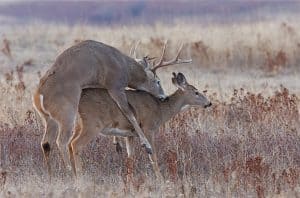Do you want more deer on your property? If so, you need to remember that females are our “production department.” Sure, they need a little help, but very little. One buck can service numerous females during one breeding season. It’s almost impossible to know for certain how many unless the area was fenced and you took DNA from the buck and all the fawns within the enclosure. However, simply having lots of females to create more fawns doesn’t mean you will be improving fawn recruitment. There are numerous considerations.
First you need to determine “do you really want more deer on your property?” It may not be an issue of simple population dynamics and “trigger finger management.” Habitat, pressure (social or from other influences like predators) or environmental issues may be the lowest common denominator. Regardless, helping all of our newborn fawns make it to an age where they are considered recruited into the herd (six months old) should be the goal for most gamekeepers. This information should help.
Improve Nutrition
Everyone should have guessed this solution. Better nutrition means healthier deer and better survival of all age classes. This is not only true for each individual animal, but ponder a pregnant doe. “Epigenetics” is a biological occurrence where certain environmental conditions a doe may experience during pregnancy can switch genes on or off in a growing fetus. Once these fetal genes are turned on or off, that condition stays with the animal for the rest of its life — no matter if the environmental conditions improve! If a doe is given excellent nutrition during the winter months when her fawns are developing, the fawns will have the potential to exhibit superior physical traits, like larger antlers and bigger body size later in life.
Then consider the nutritional requirements after the fawn(s) are born and the doe is nursing them. Most fawns are born in May and June. Healthy fawns average four to eight pounds at birth, and they will double that weight in approximately two weeks — a period during which they survive solely on their mother’s milk. However, by two weeks of age rumination begins in their stomach, and they begin to supplement their milk diet with forage. They will triple their birth weight within a month. Even though they can eat forage during this time the doe will continue on nursing them through the summer.
Fetal growth and milk production are two of the most nutritionally demanding periods for whitetail does due to the high nutrient demands of each production stage. Understanding the doe’s fluctuating nutrient requirements at different times allows us to more accurately provide what they will need to ultimately produce larger, healthier fawns. Whitetail deer milk contains approximately 7.5% fat, 8% protein and about 80% water. Removing water and evaluating the milk on a dry matter basis shows approximately 40% protein and 37% fat. Better nutrition means healthier does, healthier fawns and better recruitment.

Thomas Pettengill
Balancing the Buck to Doe Ratio
Many think that killing does is like killing next year’s fawns. While it’s obviously true for the specific doe you kill, it’s not the true for the overall herd. In most cases, doe harvest on properties that have moderate to high-quality nutrition and cover will help fawn recruitment overall. To keep a population stable at current levels, if you have good food and cover you will need to harvest 25 to 30% of the does. It’s a fact that taking the right number of does can actually increase fawn production.
With increased deer densities, habitat degradation will follow. The reason fawn recruitment increases with proper harvest is because healthy does raise more fawns. Does in poor habitat give birth to fewer fawns. Even if they do give birth to two or three fawns, those fawns then suffer lower survival rates due to decreased milk production, stress, less quality forage when weaning, and greater vulnerability to disease, severe weather, and predators — let alone what we discussed above about epigenetics.
High quality habitat means health is good and stress is low. The National Deer Association (NDA) says that with conditions such as these, does will give birth to twins, and as many as one in four does can even produce triplets. Those fawns are much more likely to survive to fall and be recruited into the herd.
The NDA cites one example among many, of the master’s research of Charlie Killmaster, who is now the Deer Project Leader for the Georgia DNR. In 2004, a high-density population on a non-hunted state park in Georgia was reduced through doe harvest. The harvest took place after the breeding season in 2004. At that point, Killmaster found 0.79 fetuses per doe. After the next rut, that number jumped to 1.44 fetuses per doe, almost doubling the first year! Forage quantity, deer body weights and other health factors also improved rapidly.
Balance Habitat with Herd Numbers
You have two ways to balance your herd with its habitat, you can either increase the quantity and quality of habitat or you can reduce the deer numbers. As stated, you need to remove 25 to 30% of the females just to keep the population level. Food plots, producing more early successional forage (via mowing, chainsaw, fire, disking or herbicide), or supplemental feeding are all ways we can bolster nutrition. If you’re not doing that, you’d better get busy with your “trigger-finger management.”

Tony Campbell
You can keep track of this and notice if you have problems simply by paying attention and keeping records. Are your food plots browsed-down lip-high before the hunting season is over? Are lower body weights coming in on your records? Are you seeing browse lines on preferred browse species? So, should you worry about your habitat or the herd numbers? My suggestion would be to pay attention to “all of the above.”
Predator Deterrence
A big variable that can amplify the problem is predators. If everything we talked about above is working well for you, but coyotes or other predators are killing a lot of fawns, you have to reanalyze. If fawn predation is significant, then continuing to kill does under these circumstances could lead to a population decline. The easiest option is to reduce your doe harvest.
Trapping or hunting predators just prior to the fawn drop can reduce predation by coyotes. However, predator removal can be a relentless, never-ending pursuit. A popular analogy often used when describing it is, “It’s like trying to plug all the holes on a strainer.” Either way, you must first track fawn recruitment to determine whether you have a problem, and you may be better off spending your resources on synchronized birthing, and bolstering fawning habitat to give the predators a much more difficult time.
Synchronized Birthing / Predator Swamping

Tom Reichner
You may ask, “How can I have any influence at all over synchronizing fawn births?” This has to do with your “trigger-finger management.” It has to do with balancing your buck to doe ratio. If you have too few bucks, does are bred over a much wider timeframe and thus will also give birth over a longer period. Some may not be successfully bred at all during their first estrus cycle, meaning they’ll try again about 28 days later. This makes each individual fawn easier to pick off.
Predator swamping refers to a high synchronization of births. There is strength in numbers. If the predators are overwhelmed by too many fawns at one time, they can’t get them all. If all the young are born at the same time, it’s like an “all you can eat buffet” for the predators — their guts are too full to continue. They can’t eat all of them, so overall, young have a better chance of survival. After a fawn reaches about a month old they do pretty well at escaping predators.
Bolster Fawning Habitat / Predator Avoidance

Touched by light images
The “predator avoidance hypothesis” predicts asynchronous (not simultaneous or concurrent in time) births. If your main defense against predators is hiding, then fewer individuals playing hide and seek will make it more difficult for a predator to find an individual than if everyone is playing at the same time.
So which strategy should you put your resources behind, predator swamping or predator avoidance? Are there data to support either? If the predator avoidance hypothesis was at play, population level survival probability would increase with more spread out births and individual fawn survival would not be affected by its birth date relative to peak fawning. However, this is not the case. In nine studies done by Penn State it was shown that patterns of fawn survival better support the predator swamping hypothesis, not predator avoidance.
With all of that known, I still believe that bolstering fawning habitat will pay off big. I’m very lucky because I built my home years ago so I could watch whitetails right out my windows. I’ve been lucky to watch a very successful young doe that has given birth the past two years right in my “back yard.” It’s said that the fawns choose their specific bed site, but I believe the mother chooses the area. It’s very interesting to watch where they hide, or where she hides them and when she visits them. She’s successfully raised twins for the past two years to over six months old. Both years she liked to bed one fawn down in the cattails and willow brush on the edge of a pond, and the other in some early successional cover that I rotate setting back by mowing every two years.
So what is good fawning cover? Fawn bed sites can be found in many different habitat types including grasslands, wetlands, forested areas, crop fields and pastures. Typically, good whitetail habitat IS good fawn birthing habitat. You see it written so many times in this publication, but it’s true, good edge cover is great fawn cover.

Joe McDonald
Fawns need cover in which to hide, but they also need a way to escape. While grasses are great fawning cover, you don’t want a thick matt of grass. Native warm season grasses, or bunch grasses are great for both fawn birthing and rearing areas. They’re also great for turkey nesting and poult rearing areas. These bunch grasses grow in clumps rather than a thick matt, so the fawns or poults can still easily navigate through them.
It sounds like a lot of work, but it doesn’t have to be. I believe the habitat end of it is actually easier than the trigger-finger part of it. Once your habitat is healthy and progressing like it should, just keeping up with the amount of does you need to harvest to keep the population level can be a daunting task. As an example, a 300 to 400-acre property with healthy populations and good habitat may need to remove 20 to 50 does or more each season just to keep the population stable. So be careful what you wish for.
Balance is what I try for. Balancing the buck to doe ratio and the herd with the habitat. I must admit that I have not kept up with the doe harvest on my home property for the past two years, and now it’s gotten to the point where next year I HAVE TO do something. I’ve already begun to line up extra people who need venison and some extra hunters to help me with harvesting an acceptable quota to bring that balance back.








